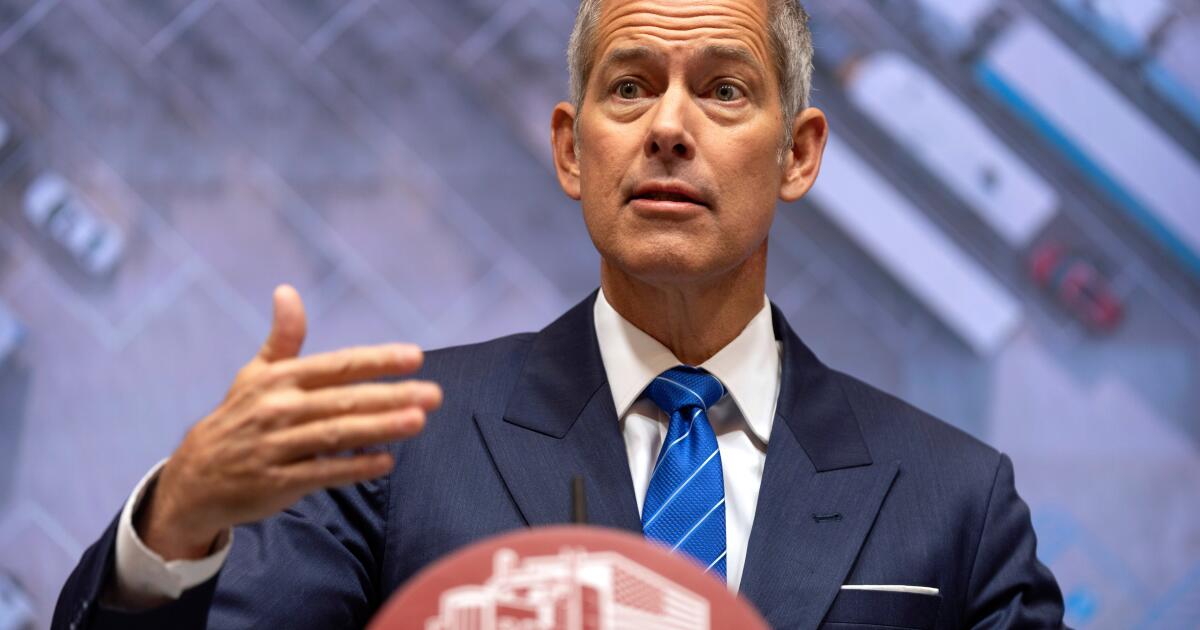New York is targeted in crackdown on immigrant commercial driver’s licenses
New York routinely issues commercial driver’s licenses to immigrants that may be valid long after they are legally authorized to be in the country, U.S. Transportation Secretary Sean Duffy said Friday. He threatened to withhold $73 million in highway funds unless the system is fixed and any flawed licenses are revoked.
State officials said they are following all the federal rules for the licenses and have been verifying drivers’ immigration status.
New York is the fourth state run by a Democratic governor Duffy has targeted in his effort to make sure truck and bus drivers are qualified to get commercial licenses. He launched the review after a truck driver who was not authorized to be in the U.S. made an illegal U-turn and caused a crash in Florida that killed three people in August. But the rules on these licenses have been in place for years.
The Transportation Department has said it is auditing these non-domiciled licenses nationwide, but so far no states run by Republican governors have been targeted. But Duffy said Friday that this effort is not political, and he hopes New York Gov. Kathy Hochul will take responsibility and work with him. He said it is about making sure everyone behind the wheel of an 80,000-pound truck is qualified and safe.
“Let’s hold hands and sing Christmas music and fix your system,” Duffy said. Instead, he said, the response appears to be trying to “dodge, divert and weave” without taking responsibility for the problems.
Widespread problems found in New York audit, feds say
Duffy said federal investigators found that more than half of the 200 licenses they reviewed in New York were issued improperly, with many of them defaulting to be valid for eight years regardless of when an immigrant’s work permit expires. And he said the state couldn’t prove it had verified these drivers’ immigration status for the 32,000 active non-domiciled commercial licenses it has issued. Plus, investigators found some examples of New York issuing licenses even when applicants’ work authorizations were already expired.
“When more than half of the licenses reviewed were issued illegally, it isn’t just a mistake — it is a dereliction of duty by state leadership. Gov. Hochul must immediately revoke these illegally issued licenses,” Duffy said.
New York has 30 days to respond to these concerns. State DMV spokesperson Walter McClure defended the state’s practices.
“Secretary Duffy is lying about New York State once again in a desperate attempt to distract from the failing, chaotic administration he represents. Here is the truth: Commercial Drivers Licenses are regulated by the Federal Government, and New York State DMV has, and will continue to, comply with federal rules,” McClure said.
Duffy has previously threatened to pull federal funding from New York if the state did not abandon its plan to charge drivers a congestion pricing fee in New York City and if crime on the subway system was not addressed. The Transportation Department also put $18 billion of funding on hold for two major infrastructure projects in New York, including a new rail tunnel beneath the Hudson River between New York City and New Jersey, because of concerns about whether the spending was based on unconstitutional diversity, equity and inclusion principles.
Previous efforts to restrict immigrant truck drivers
Immigrants account for about 20% of all truck drivers, but these non-domiciled licenses only represent about 5% of all commercial driver’s licenses. The Transportation Department also proposed new restrictions that would severely limit which noncitizens could get a license, but a court put the new rules on hold.
Duffy has threatened to withhold millions from California, Pennsylvania and Minnesota after the audits found significant problems under the existing rules, like commercial licenses being valid long after an immigrant truck driver’s work permit expired. That pressure prompted California to revoke 17,000 licenses. No money has been withheld so far from any state because, Duffy said, California has complied and the other two states still have more time to respond.
Trucking trade groups have praised the effort to get unqualified drivers and drivers who can’t speak English off the road, along with the Transportation Department’s actions last week to go after questionable commercial driver’s license schools. But immigrant advocacy groups have raised concerns these actions have led to harassment of immigrant drivers and prompted some of them to abandon the profession.
“For too long, loopholes in this program have allowed unqualified drivers onto our highways, putting professional truckers and the motoring public at risk,” said Todd Spencer, who is president of the Owner-Operator Independent Drivers Assn.
Funk writes for the Associated Press.
